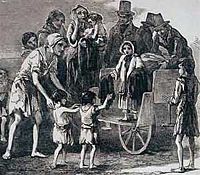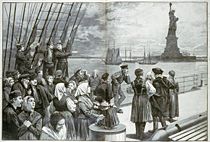| wiki | search |
Main Page | Groups and Assignments | Bios | History | Harlem | Diversity Today | Help
Colonial America | Early America | Modern America


From 1840 to the 1860s, New York City underwent a permanent change socially and politically during the massive influx of immigrants – mainly from Great Britain, Ireland, and Germany. The vast influx created racial tension between native-born workers and newly arrived immigrants; it held especially true to the blacks and Irish immigrants.
By 1841, about 100,000 Irish Catholic immigrants had flooded into the city, and this number soared in the wake of the Irish potato famine in 1846. The blacks and Irish immigrants shared commonalities in terms of social status and economic standing and were thus forced to compete for the worst housing and lowest paying jobs in the city. According to the statistics provided by Joseph P. Ferrie, compared to the newly arrived British and Germans in New York, the Irish had the worst downward trend in occupational change – 37.5% from white collar to unskilled and 52.2% from skilled to unskilled. Evidently, they faced direct competition for jobs in labor market with the blacks. Resentment and hatred resulted from competition which escalated racial tension between these two groups. The Irish immigrants took the blacks' jobs away since they were willing to work for less money. In addition, the blacks took over Irish jobs when they went on strike. As a result, ethnic violence and gang activities increased. Civil disobedience spread throughout New York City, and later on led to the outbreak of the Draft Riots.
Sources: Joseph P. Ferrie. [Yankeys Now: Immigrants in the Antebellum United States, 1840-1860]. New York: Oxford University Press, 1999.
